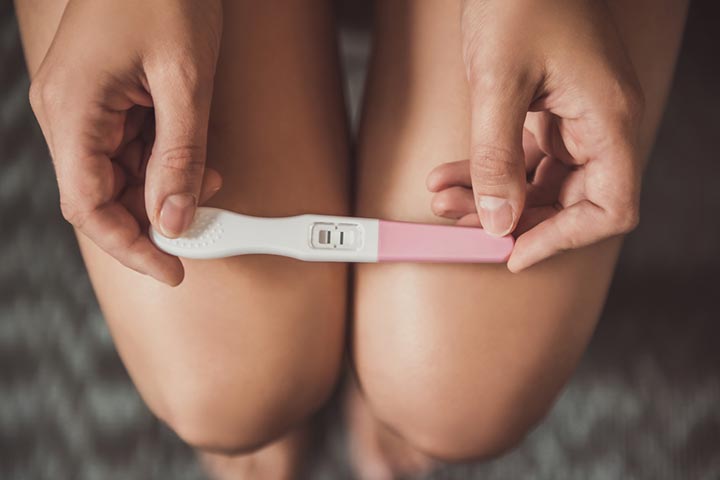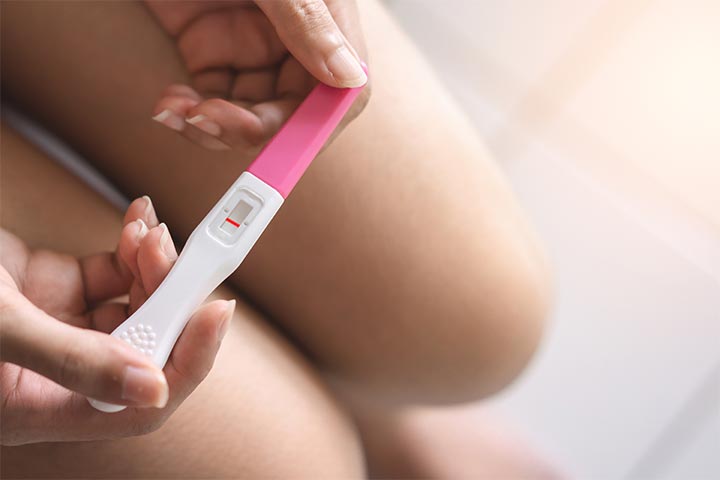
Image: Shutterstock
For couples who are trying to conceive, home pregnancy tests have become the most convenient option to check whether they are pregnant or not. A pregnancy test is both time-saving and affordable to find out if you have conceived.
Since their first arrival in the 60s, home pregnancy tests have become more sophisticated with tons of transformation. You get false positives, false negatives, and sometimes there’s the dreaded faint line leaving you completely clueless on what it indicates. So, regardless to say, home pregnancy tests can be confusing, albeit it’s the simplest option out there to find out if you’re pregnant.
Pregnancy Test: When Should You Take It?
If you are trying for a baby, it’s best to wait until the first day of your missed period to get an accurate result. Several home pregnancy tests claim to give you accurate results even before the first day of your missed period, but it’s always best to wait until after (1).
If you can’t wait until the day of your missed period, it’s best to wait for at least 14 days after possible conception. Again, this depends upon the test kit that you use and how sensitive they are. Make sure to also read the instructions on the package to know the best time you can take the test.
To reduce your chances of getting inaccurate results, it’s recommended to take the test in the morning, soon after you wake up. This is because too much consumption of fluids in your body before the test could alter the result and give you a false negative.
Pregnancy Test: How It Works
Naturally, the question would arise in your mind — why wait? This is because when an egg is fertilized, it would attach itself to the uterine lining and cause placenta formation along with the production of the human chorionic gonadotropin (hCG) hormone. Pregnancy is detected by checking the presence of hCG hormone in blood and urine. Shortly after conception, the concentration of hCG might be low, which then doubles after every few days. So, an early pregnancy test may not be able to give accurate results as the hCG concentration might be low (2).
Another factor that needs to be taken into account is the regularity of your menstrual cycle. If you have irregular periods, you might not be able to calculate the exact date of your ovulation and the due date of your period. This could again mean that you could take the test too early, which might give you an inaccurate result.
False Positives
A false positive is when you get a positive result after taking the test when you’re not actually pregnant. Though false positive is rare, it could happen (3).
There could be several reasons behind getting a false positive on a pregnancy test. Let’s look at a few of them:
- If you had a pregnancy loss soon after implantation, it is known as biochemical pregnancy. In such cases, the miscarriage occurs within a few weeks of conception. Biochemical pregnancies can be identified with elevated levels of hCG hormone and may not be visible in an ultrasound.
- If you’re taking fertility drugs that contain hCG, it could also result in a false positive when the test is taken soon after taking the medication.
- High levels of hCG can also result from certain health conditions such as gestational trophoblastic disease, a deficiency of immunoglobulin A (IgA), and certain types of tumor or cancer (4).
- Other reasons include menopause, ectopic pregnancy, and issues with ovaries.
False Negatives
A false negative is when you get a negative result after taking the home pregnancy test when you’re actually pregnant. Home pregnancy tests rely on the concentration of hCG hormone in the urine (5). If the concentration is too low, you’re likely to get a negative result. Below we list down a few reasons:
- When the test is taken too early, there’s less chance of getting an accurate result. A home pregnancy test works best when taken a day after the first day of your missed period. It’s also best to repeat the test after a week for more accurate results.
- When checked too soon, you’re likely to get a false negative. So, read the instructions on the package and give the test time to work.
- A false negative could also result from diluted urine. Hence, it’s recommended to take the test first thing in the morning soon after you wake up.
What To Make Of The Faint Line On Your Pregnancy Test?
Home pregnancy tests have evolved to a great extent even since they first arrived in the market. Most tests today distinguish themselves by how fast they can provide a result and which indicators they use — pluses, minuses, lines, colors, and digital. There are times when the indicators may not give you a clear result and appear faint or ambiguous. This could be because of human errors, manufacturing issues, or in rare cases when the urine absorbs or evaporates into the result window, causing the indicator to appear faintly.
In any case, home pregnancy tests are designed to give you an accurate result — you are either pregnant or you’re not; there’s no maybe. If you’ve followed the package instructions and used the test correctly, and the indicator appears, then you’re most likely pregnant. However, instead of being apprehensive of the result you got, you could redo the test or visit a healthcare provider for accurate results.
Home pregnancy tests claim to be 99% accurate. But if you’ve gotten mixed results, make an appointment with your healthcare provider so they can confirm the pregnancy with a blood test or ultrasound examination. Similarly, if your test is negative, and your period doesn’t begin after a week, or you suspect that you might be pregnant, you could take the test again or consult your healthcare provider as missed periods could result from certain health conditions, lifestyle changes, or problems with your ovaries.

















